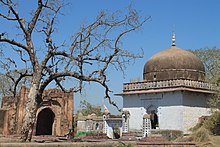| Siege of Ranthambore | |||||||
|---|---|---|---|---|---|---|---|
| Part of Alauddin Khalji's conquest | |||||||
 Interior view of Ranthambore fort | |||||||
| |||||||
| Belligerents | |||||||
|
| Chahamanas of Ranastambhapura | ||||||
| Commanders and leaders | |||||||
|
Alauddin Khalji Ulugh Khan Nusrat Khan † |
Hammiradeva † Virama Bhimasamha † Jaja † Kshetra Singh Parmar † Tak Gangadhar † Muhammad Shah (POW) Kehbru (POW)[1] | ||||||
| Strength | |||||||
| Unknown | 10,000 to 12,000[2] | ||||||
In 1301, Alauddin Khalji, the ruler of the Delhi Sultanate in India, conquered the neighbouring kingdom of Ranastambhapura (modern Ranthambore).
Hammira, the Chahamana (Chauhan) king of Ranthambore, had granted asylum to some Mongol rebels from Delhi in 1299. He refused requests to either kill these rebels or hand them over to Alauddin, resulting in an invasion from Delhi. Hammira lost his general Bhimasimha to an army led by Alauddin's general Ulugh Khan, and his brother Bhoja defected to Alauddin some days later. After recovering from these initial reverses, Hammira's generals (including the Mongol rebels) defeated Ulugh Khan's army at a mountain pass near Ranthambore. Alauddin then dispatched his general Nusrat Khan to reinforce Ulugh Khan's army, but Nusrat Khan was killed while besieging the fort.
Alauddin then himself took control of the operations at Ranthambore. He ordered the construction of a mound to scale its walls. After a long siege, the defenders suffered from a famine and defections. Facing a desperate situation, in July 1301, Hammira and his loyal companions came out of the fort, and fought to death. His wives, daughters and other female relatives committed Jauhar (mass self-immolation). Alauddin captured the fort, and appointed Ulugh Khan as its governor.
- ^ Rima Hooja 2006, p. 306–308: "A detailed description of Hammir’s last fight is given in the Rajput sources. According to Hammir Mahakavya, nine brave men fought by his side in his last hour — his brother Viram, Tak Gangadhar, four Mongol (brothers), Kshetra Singh Parmar and two others...Muhammad Shah and Kehbru, grateful to the last to the Rajput king for his hospitality and sacrifice, fought side by side with their patron"
- ^ Rima Hooja 2006, p. 307:"Meanwhile, Hammir had completed his own preparations to withstand the siege. According to Yahya, Rai Hammir had 12,000 cavalry, several famous elephants and numerous infantry troops at his command, while Amir Khusrau mentions Hammir as having about 10,000 horses"
